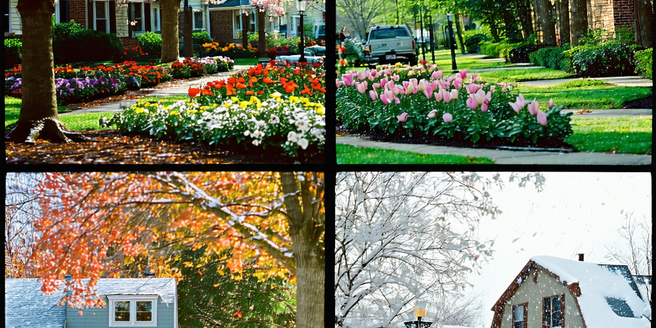
Understanding Temperate Zones: A Climate Overview
Temperate zones are regions characterized by moderate temperatures, falling between the extremes of hot tropical areas and cold polar zones. These zones typically experience four distinct seasons: winter, spring, summer, and autumn. Each season brings its own set of climatic changes affecting temperature, precipitation, and daylight. The moderate climate in temperate zones supports a diverse range of ecosystems, from deciduous forests to grasslands. This diversity of flora and fauna is indicative of the adaptability present within these regions. Human activities like agriculture, urbanization, and industry are highly prevalent due to manageable climate conditions. Understanding these zones is crucial for grasping global climate dynamics and planning sustainable development strategies. Adaptation and resilience to climate change impacts in temperate zones require vigilant monitoring and sustainable environmental practices.
The Science Behind Urban Heat Islands
Urban heat islands (UHIs) manifest as localized areas of elevated temperatures, notably warmer than surrounding rural regions. This phenomenon is driven by human activities, such as transportation and industry, coupled with the abundance of heat-retaining surfaces like concrete and asphalt. As cities expand, natural landscapes are replaced by infrastructure that absorbs and retains heat, disrupting local temperature regulation. Buildings and vehicles emit additional heat, exacerbating the effect. Consequently, UHIs contribute to increased energy consumption for cooling, heighten heat-related health risks, and alter local weather patterns, sometimes intensifying storms. Understanding the science behind UHIs is essential for urban planners and policymakers aiming to develop strategies that mitigate these effects. Implementing green spaces, reflective roofing materials, and proper urban planning are crucial steps toward reducing UHI impact, promoting cooler, more livable urban areas.
Impact of Urbanization on Local Climates
Urbanization significantly alters local climates, often exacerbating temperature extremes and modifying precipitation patterns. The transformation from rural to urban landscapes involves replacing vegetation with impermeable structures, which affects natural water absorption and increases surface runoff. The resulting shift in energy balance leads to the urban heat island effect, raising temperatures and potentially extending heatwaves. This localized warming influences atmospheric conditions, affecting cloud formation and rainfall distribution. Urban areas often experience reduced wind speeds and stunted natural air circulation, further intensifying temperature-related issues. The increase in greenhouse gas emissions and air pollutants from dense urban centers contributes to climate change on a broader scale. These urban-induced climatic shifts necessitate innovative urban design and planning, aimed at integrating sustainable practices to mitigate adverse effects and enhance resilience against climate variability and extremes.
Comparative Analysis: Temperate vs Urban Heat
Comparing temperate zones and urban heat islands sheds light on the stark contrasts in climate experiences. Temperate zones exhibit moderate, well-distributed weather patterns conducive to diverse ecosystems and sustainable human settlement. They leverage their climate for agriculture, forestry, and natural habitat conservation. In contrast, urban heat islands often suffer from overheating due to human activity and infrastructure. These cities and towns experience higher temperatures, altered humidity levels, and reduced air quality, impacting residents’ quality of life. While temperate zones are defined by seasonal variation, UHIs endure intensified heat, particularly during warmer months, which strains resource availability and public health systems. A comparative analysis underscores the necessity of informed urban planning that harmonizes the built environment with natural climatic patterns, reducing thermal stress and promoting sustainable urban ecosystems alongside moderate climate benefits.
Mitigation Strategies for Urban Heat in Temperate Areas
Mitigating urban heat in temperate areas requires a multi-faceted approach to balance human development and environmental preservation. Strategies include increasing green spaces such as parks, green roofs, and urban forestry, which provide shade, sequester carbon, and improve air quality. Implementing reflective and light-colored building materials reduces heat absorption, while enhanced urban planning considers wind corridors to aid natural cooling. These efforts can be complemented by expanding public transportation and promoting energy-efficient infrastructure to decrease heat emissions and pollution. Community engagement is vital, encouraging local participation in sustainability initiatives and responsible consumption. Such integrated mitigation strategies not only curb urban heat but also enhance biodiversity, improve public health, and foster climate resilience. Proactive policies and investments are needed to adapt to and ameliorate urban heat effects in these climate-sensitive temperate regions.
Future Prospects: Balancing Urban Growth and Climate
The future of urban growth in the context of climate change is a critical global challenge. Balancing development and environmental sustainability requires innovative strategies to foster highly habitable urban environments. Emphasizing green architecture, renewable energy sources, and efficient public transportation will drive cities toward lower carbon footprints. Urban planners must prioritize the preservation of natural landscapes and biodiversity alongside infrastructural expansion. Fostering smart city technologies and resilient planning will address urban climate challenges, ensuring sustainable urban growth. Municipal policies need adaptation to incorporate climate-responsive designs that regard environmental risk assessments and long-term resilience. Urban environments can thrive by leveraging technology, policy reform, and community participation to decrease environmental impact while maintaining economic vitality. Anticipating future climate scenarios, active collaboration among governments, businesses, and citizens is essential to create balance and harmony between urban advancement and climate stewardship.
